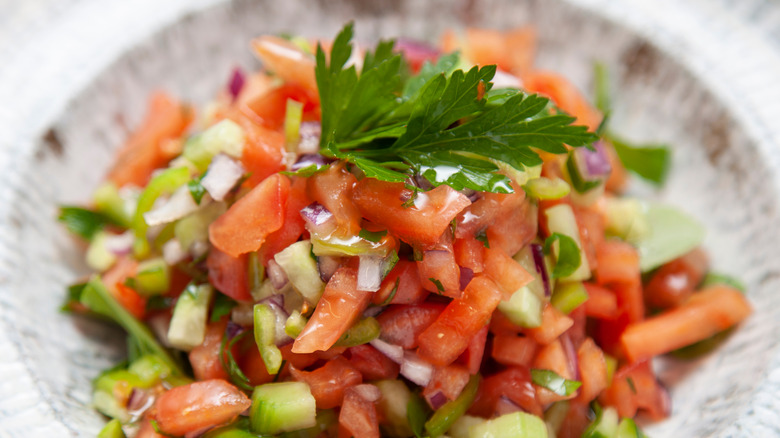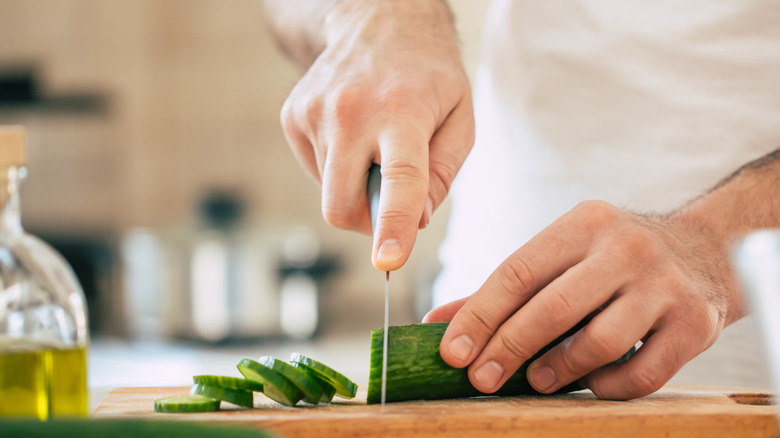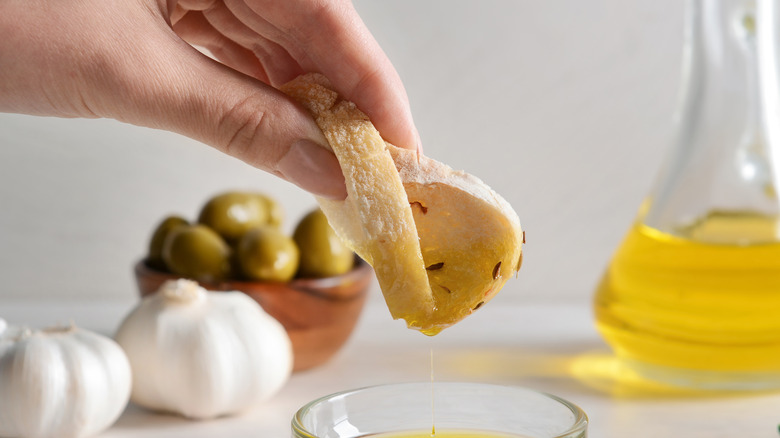Çoban Salatası: The Turkish Salad You Should Know About
In the heat of summer, making dinner can feel like a hassle. It can be tempting to choose cold summer recipes to beat the heat, but wait — we may have a solution for those hot evenings you can't imagine turning the oven on. There is a way to put together a fulfilling meal without overheating yourself or your home, and the vegetable drawer of your fridge has the answer. It's time to prepare a salad.
Salads were historically a mixed bowl of vegetables and leafy greens enjoyed by Greeks and Romans, according to FoodTimeline.org, and vegetables were doused in a salty dressing (this is why we call it salad, thanks to all the "sal" — or salt — the greens were flavored with). It makes sense that Mediterranean dishes are often light and flavorful; as summer temperatures skyrocket, refreshing produce and cool ingredients from the sea come to the rescue. It feels only right that some of the best summer salads are from this region.
The origins of çoban salatası
Çoban salatası is assumed by Miss Party to have originated when Turkish shepherds carried tomatoes, cucumbers, and onions with them into the fields for lunch, and the simple on-the-job dish became a staple in their daily routines. Do not be mistaken: Simplistic roots do not make this summer recipe any less delicious. Chock full of crunchy, refreshing vegetables, çoban salatası is an easy-to-make meal or side dish, prepared and served quickly to hungry family and guests.
Though Turkish in creation, this shepherd's salad is actually made up of veggies not native to the Mediterranean country. According to Smithsonian Magazine, ingredients like tomatoes were only transported from the Americas to the Old World during the 16th century. Cucumbers and green chilis are native to India, so the çoban salatası was most likely invented after the globalization of produce (via Integrated Pest Management at the University of Missouri).
What is çoban salatası?
The book "Essential Turkish Cuisine" by Engin Akin describes Turkish çoban salatası as a summer salad with a refreshing and mildly acidic base of red tomatoes and cucumbers mixed with green chili, onion, and parsley. After peeling and finely chopping tomato and cucumber into small pieces, onion and green chili are minced and tossed into a bowl with them. If you're worried about serving raw onion in your salad, you're not alone. Raw onion tends to be pungent and can easily overwhelm a dish. Luckily, if this is a concern, Food Hacks suggests soaking onion in ice water and vinegar, then salting them 15 minutes before serving. Taking one of these steps will reduce the intense flavor onion has and will make your çoban salatası more balanced.
Right before serving, Akin mixes olive oil, a pinch of salt, and lemon juice into a dressing to drizzle on top. This will keep your salad from becoming soggy, and the lemon's citrus notes will add to the refreshing nature of this dish (via Recipe Tips). Olives can also be added as a salty garnish for a briny complexity, but if you really want to enhance your salad experience, Turkish Style Cooking adds pomegranate molasses to their dressing to give the çoban salatası natural sweetness.
What does çoban salatası taste like?
Çoban salatası is most commonly eaten as a summer dish throughout Turkey because of its simple, refreshing nature (via Best Middle Eastern Recipes). The base of the shepherd's salad is primarily tomatoes and cucumbers, both of which are in-season and readily available during the summer months. Made of 95% water, cucumbers can help keep you hydrated and "cool as a cucumber" because, as The Spokesman-Review states, the inside temperature of a cucumber always remains cool. Cucumber adds a crunchy aspect to the salad, balancing out the tomato's soft, juicy texture.
Onion and green chili are meant to act as mild, subtle flavoring that can enrich the dish. Use a traditional mild or sweet green chili with the seeds removed before mincing them for the salad. A great salad should always be served with crusty, toasted bread like this ultra-crispy garlic bread to sop up any leftover dressing and vegetable juices. No part of this dish should go to waste!



